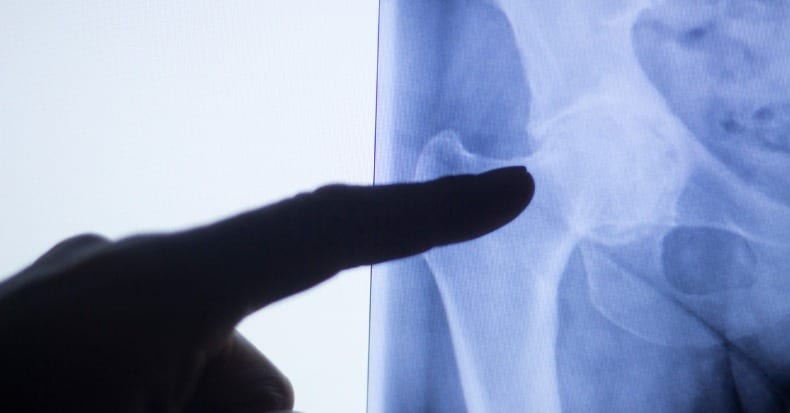Femoroacetabular impingement (FAI) is a pathological hip condition found in 17% of the population, and it’s caused by abnormal contact between the ball of hip and the socket. To be more precise, it’s the head-neck junction that impinges against the rim of the acetabulum. There are three types of FAI: cam, pincer, or a combination of the two. The cam deformity (also called “pistol-grip”) is from too much bone at the head-neck junction and is found in 65-75% of FAIs (often active young men 20-30 years old). The pincer deformity is from too much bone off the front of the acetabular rim (like a spur), and it is often seen in middle aged, active women. Less than 10% have both cam and pincer deformities together.
In some cases, FAI can arise without either a cam or pincer deformity and occurs as a consequence of extreme hip movements like those associated with ballet, gymnastics, or weight lifting (squatting). There are actually several types of impingement syndromes in the spine-pelvic region, but we will focus on that which occurs at the hip joint specifically, the FAI syndrome.
The pain associated with FAI results from repeated abutment, or contact, between the two bones leading to injury of the adjacent cartilage and/or labrum, which is a crescent-shaped band of cartilage that stabilizes, lubricates, and cushions the hip joint. Over time, repeated trauma can lead to hip joint osteoarthritis (OA). In fact, in a large population study, researchers observed cam and/or pincer deformities in 71% of males and 37% of females with hip OA.
The clinical presentation of FAI is usually found in healthy, active adults between 20-50 years in age. In older patients, it’s frequently accompanied by hip OA. Anterior FAI presents with pain in the front of the hip, groin, pubic bone, and/or anterior thigh and often arises from activities that include running/sprinting, kicking sports, hill climbing, and prolonged/repeated sitting in low chairs – any activity where the hip flexes forward (knee-to-chest positions).
Impingement from pincer deformities can also give rise to posterior FAI, or pain in the back of the hip joint. When this occurs, pain in the buttock and sacroiliac joint (SIJ) have to be differentiated from pain arising from the low back and/or SIJ. Repeated hip hyperextension such as from fast walking and hiking downhill are common causes.
So, can chiropractic help? Short answer – YES! The current research shows that non-surgical care for FAI should include avoiding activities that impinge the hip (discontinuing or modifying a sport or daily activity), reducing inflammation, and exercising to stretch the hip flexors and strengthen hip extensors. Once a proper diagnosis is made, your doctor of chiropractic can advise you on the best ways to manage your FAI.
Thousands of Doctors of Chiropractic across the United States and Canada have taken "The ChiroTrust Pledge":
“To the best of my ability, I agree to
provide my patients convenient, affordable,
and mainstream Chiropractic care.
I will not use unnecessary long-term
treatment plans and/or therapies.”
To locate a Doctor of Chiropractic who has taken The ChiroTrust Pledge, google "The ChiroTrust Pledge" and the name of a town in quotes.
(example: "ChiroTrust Pledge" "Olympia, WA")
Content Courtesy of Chiro-Trust.org. All Rights Reserved.

